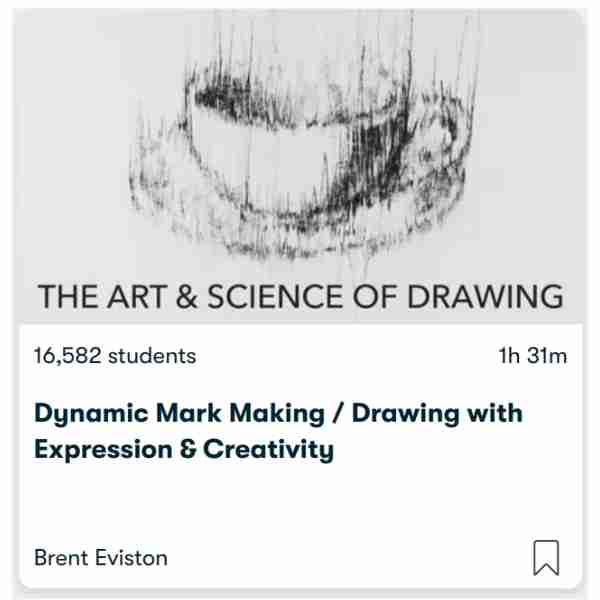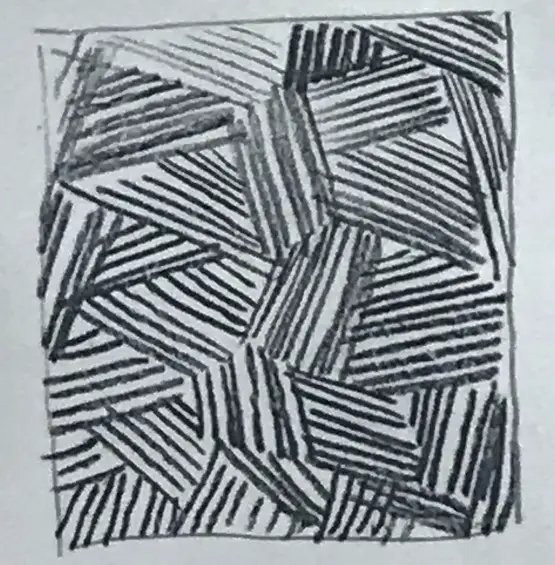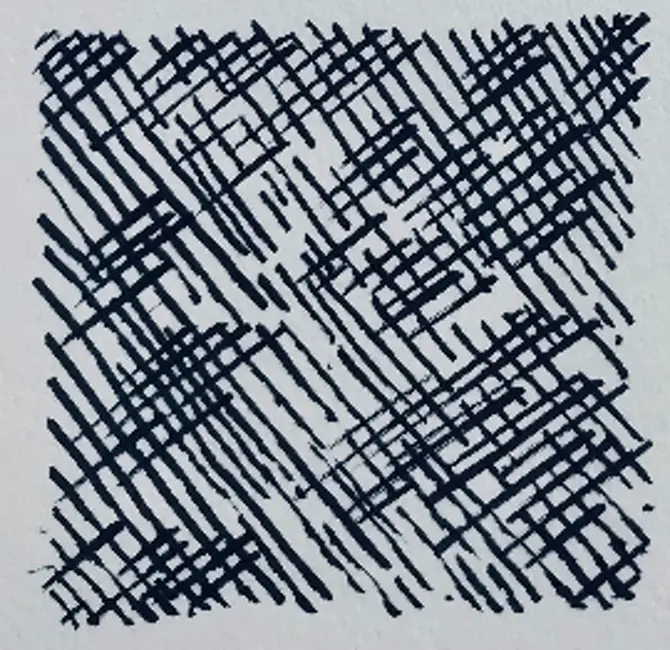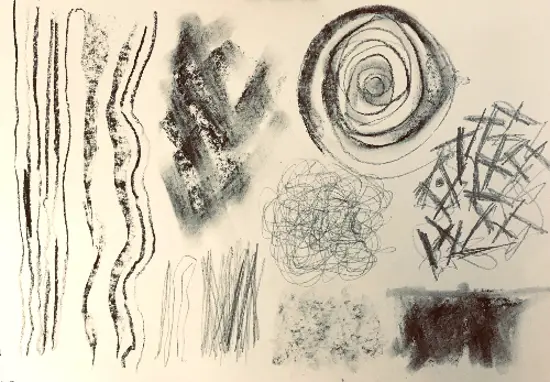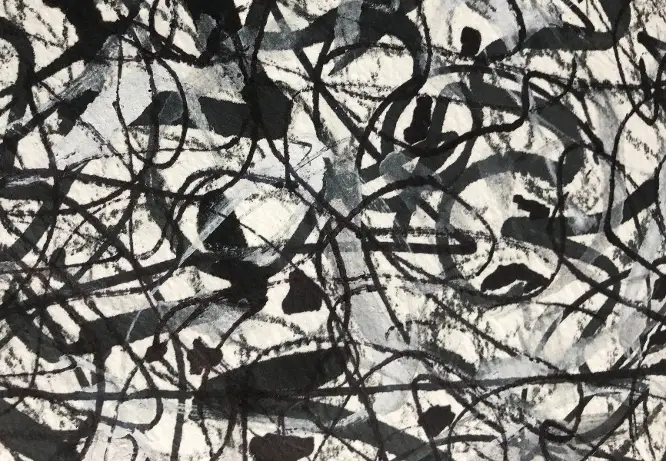When it comes to drawing, the action itself is depicted by making a series of marks onto a piece of paper. Many of these marks are very specific and allow an artist to create different textures that are easily recognized by the human eye. Among the most important marks that you will want to know more about are the essential fundamentals of mark-making techniques.
WHAT IS MARK-MAKING?
Like any other tool used for creating art, an artist uses drawing techniques that include all sorts of simple methods and tricks to mark something onto paper. Whether from a pencil, pen, paintbrush, or crayon, the choice is wide open to the drawing media employed.
The physical mark-making process is carefully applied using calculated pressure to create visible marks on drawing paper or similar media.
WHAT ARE THE MARK-MAKING TECHNIQUES?
At some point in the creative process of making art, simple marks were used to help create a picture or drawing that resembled or reproduced the same textures and patterns of objects that humans saw every day.
As time went on, many of these techniques for drawing using a series of marks were taught to others. Aside from well-established methods, the number of techniques used to make marks includes dozens of variants and styles.
The Art & Science of Drawing / DYNAMIC MARK MAKING
WHAT ARE THE 4 MARK-MAKING METHODS?
Four traditional methods for making marks are centuries old and are the first drawing methods taught to art students. These include hatching, cross-hatching, stippling, and Scumbling.
In particular, hatching and cross-hatching will include characteristics that further create texture and specific patterns. These 4 basic methods can create a sketch or drawing using these techniques.
The following drawing course will provide a real insight into how to develop your mark making skills and intergrate them into your drawing.
Please take a look at this drawing and sketching video course I have created. Use this link.
Hatching
Hatching is a series of lines that are short lines that are drawn in the same direction. The illusion of light and shadow is achieved by spacing the lines further away or closer depending on how light or dark the surface area is.
Thicker lines are drawn to make darker areas, while thinner lines will help create highlighted spots. Ideally, the lines must face the same direction when using this technique.
Cross Hatching
Cross hatching is similar to hatching but allows horizontal lines to intersect vertical lines. The same values are used to highlight and shadow by adjusting the thickness or thinness of drawn lines.
There is no specific rule that cross-hatched lines must be angled to 90 degrees, as long as the direction of both sets of lines matches their given direction.
Stippling
This is a technique that uses dots to create a picture. Dots can be larger or smaller to enhance light and shadow elements and often allow selective spacing between each dot to help create texture and patterns.
Finely drawing dots with ample spacing is great for highlighted areas, while darker and densely-packed dots are great for shadows. Stippling takes time but is highly rewarding when the dots create any detailed drawing.
Scumbling
This technique is also known as doodles or scribbles, depending on which artist you ask. These are free-form lines that resemble bunched-up or kinky-looking hair clumps.
No pattern can describe how long these lines are or how scribbled they appear. Any drawing that uses this technique can fill in shadow areas easier than highlighted spots. This free-hand form of drawing is great for making sketches and quick studies of any object.
Different Lines and Patterns
Line patterns are an exception to hatching, which uses long or short lines to create the illusion of an emerging pattern. This is used to bring out detail that is impossible if you solely use the hatching technique. These lines can be thick or thin depending on the pattern being drawn, but for the most part, one must stick to the rule of spacing and grouping to make a pattern appear.
Contour lines
This is another exception that can apply to hatching and cross-hatching drawings. These lines must follow a curved line and are not limited to the length of each line drawn. Another exception is that contour lines can be reversed at any angle to bring out fine detail such as hair, surface texture, or directional angled curves of an object. To bring out highlight and shadow, contour lines’ light and dark values can be increased or decreased.
WHAT ARE THE 4 CHARACTERISTICS OF MARK-MAKING?
If there was ever a formula for making marks, it would best be described as the four fundamental steps contributing to mark-making. Like making a recipe, each food ingredient is added to produce the desired result. And though it might sound very overly stated, these facts are worth mentioning to anyone who has never formally gone to art school.
A single mark makes a dot
A single dot onto a piece of paper is a mark with no other shape except a dot. It can be light or dark and is better when lighter dots are combined to create darker spots. These individual dots can be darkened as you go and serve as a guide for creating highlight and shadow. Individual dots can also help form details and textures that are typically the last part of making dot drawings.
An elongated mark becomes a line
And a continuous line that is drawn is considered an elongated mark. This line doesn’t need to be as long as the object itself. It can be comprised of shorter lines that run parallel to each line drawn next to each other. These lines can be darkened at any point, with some lines being heavier and darker on one end and lighter on the other. To add detail to established lines, any area can be darkened to create different textures or detail.
A Set of Marks Becomes a Shape
Like the old Twos company and threes a crowd, there is some truth in a set of marks that help define shapes. In this case, the more that marks are added to a drawing, the more it becomes a clearer picture. And while these shapes are recognized by the human eye. They are tricked into seeing a shape that is accepted as-is without hesitation. Nearly all drawings that use mark-making techniques need to include a set of marks to complete a picture.
A sequence of repetitive marks creates a pattern
Drawing with mark-making techniques will also use repetitive marks to help create a pattern. This can include surface details such as texture and visible patterns and will likely repeat this process throughout the drawing. As if these patterns could be copied and pasted, repetitive patterns drawn with marks don’t need to be exactly alike, allowing your drawing to remain original no matter how repetitive the technique becomes.
WHAT ARE MARK-MAKING TECHNIQUES IN ART?
Play Video Mark Making With Charcoal & Graphite
The defined mark-making techniques have been carefully documented throughout history, and every famous artist who became famous uses traditional mark-making techniques. In recent years, newer methods have been created that are part of the subgenre of art culture, which embraced new mark-making techniques. Here is a sample of the newer variants of mark-making.
Modern Mark Making
Modern art is an exciting concept pushing the envelope for traditionally considered art. Whenever artwork combines mark-making styles such as oversize comic book images or random intersected doodles, there will always be a modern twist on what art is all about. Love it or hate it, modern mark-making comes in many forms that often sell like crazy due to its unorthodox approach to outweigh traditional art value.
Abstract Intuitive Marks
As the Joker in that Batman: The Dark Knight film once said, ‘there is order out of chaos, and sounds about right when describing Abstract intuitive. This artwork takes mark-making to a whole new level while completely destroying the narrative. Take a look as Jackson Pollock masterfully creates, and this tells you everything about his thoughts. It might be called Abstract expressionism, but it’s really a chaotic Scumbling of colors on canvas.
Digital marks and making your mark using sound
The future of digital art is undoubtedly not NFTs, even though there is likely the presence of mark-making apps that are used. A whole new generation of artists is exploring mark-making using free online programs and photoshop to create their digital mark. One example is Jonathan Morse, who is likely selling his art as an NFT already. Besides digital mark drawings, all emotions and sound mark-making methods use music and mood to create mark-making art.
Making your mark: Graffiti inspired art
Real artistic graffiti is an expression that goes way beyond the realm of being an eyesore on the side of a building. Artists like Banksy have taken graffiti to new expressionism and public awareness levels. Newer artists use mark-making techniques to explore their ideas and feelings through graffiti. The same principle is applied with a spray can instead of a pencil, giving these drawings a rough inner-city feel.
Illumination
Light painting is not a new technique but has been around since 1889. It uses illumination and photography to create drawings that employ a mark-making process. Most of the time, these include Scumbling but can also feature continuous lines and dots. The process is time-consuming and takes careful planning and very long exposures to capture the light. The result is impressive and haunting.
Hatching and Crosshatching techniques
One of the most classic forms of mark-making, this technique makes quick drawings that don’t need too much detail but speak volumes for texture and pattern design. This technique is also perfect for making thumbnail sketches drawn in a couple of minutes and more references.
Pointillist Mark Making: Pointillism
This is often called painting with dots and uses color rather than black and white drawings. Many of the most famous paintings using pointillism techniques changed how we view the world. It’s yet another way mark-making has gained popularity over the last century.
Expressing Emotions and Signature Marks
Drawings that include mark-making techniques rely heavily on raw emotion. The random and highly expressive scribbles and scratches are another way to convey turmoil or inner struggle, while softer hatching and cross-hatching styles tend to feel softer and more relaxed. The most serene pictures use dots to make everything feel warm and fuzzy.
A BASIC DESCRIPTION OF MARKS
What is mark-making?
Mark making is an art method that can use dots, lines, and scribbles to create an artistic picture. The primary techniques include hatching, Cross hatching, Stippling, and Scumbling. Some variants can include contour lines and line pattern-making that apply to hatching and cross-hatching techniques.
Why use gestural qualities?
The quality of an artist’s work will heavily rely on the gestural quality of their work. This includes how they use mark making and which method is preferred. To a large degree, the action of gestural quality also shows an artist’s style and medium. It helps to further bring out more character to their work, which gains respect for the method used.
Capturing life
Simply using a mark-making technique is not enough to gain attention in a drawing. The content of a drawing must draw the viewer’s eye to something inspiring or thought-provoking. A good example is Vincent Van Goghs artwork filled with twisted passion and wild colors. Many of his mark-making paintings still make an excellent reference to capturing life using relatively simple painting tricks.
Tonal modeling
Any drawing picture needs to reflect the natural light around an object. This will include light and shadow, but formerly it’s also considered that tonal modeling plays a big part in how things are drawn. Despite using mark-making techniques, tonal modeling helps create a dramatic image based on illuminated objects.
Painting is marking
Before any painting is completed, a sketch is drawn using lines as a guide. The real work comes by using marking techniques for many of the details. Whether dots are used, or paint is splattered around, marking methods are fast and straightforward for any emerging artist to become proficient.
THE TRADITIONAL GRAPHITE PENCIL
The most common item that belongs to the artist is a graphite pencil. It can be taken anywhere as long as there is drawing paper and is one of the most practical tools to make mark-making sketches and drawings virtually anywhere.
HATCHING IN DRAWING
Hatching is used to make pictures that quickly plan an idea or scene. It’s an excellent way to practice shading techniques since this method isn’t using the standard shading or shadowing that allows for smoothing or smudging. As a result, blocking of highlight and shadows works backward with doing the shadows first.
A PENCIL DRAWING CONTAINING ALL THE DIFFERENT TYPES OF MARKS
Using the various mark-making tricks will need to combine a flow that isn’t looking out of place. It would be perfectly fine to add pointillism with cross-hatching or adding contour lines with cross-hatched detail. To add all of these styles together is a careful balance. Knowing what belongs rather than throwing everything into the menu simultaneously.
GRAPHITE PENCIL MODELED ON PAPER TO CREATE GRADUATED EDGES
Using a graphite pencil is a great way to control graduated edges since an artist can apply light lines on the first light sketch. The value of light over dark is the control of the pencil itself so that mark-making lines can become distinct as the details are added slowly. Observing how a model is being lit will determine how the finished edges will appear and look more natural.
My Favourite Drawing Resources
General Drawing Courses. I really like Udemy if you are looking to develop your knowledge of drawing techniques Udemy is an excellent choice due to its wide range of creative courses and excellent refund policy. They often have monthly discounted deals for new customers, which you can check here. Use my link.
Sketching and Collage. Take a look at this sketching resource I have created. Use this link.
Proko. Is one of my favorite teachers who surpasses in the teaching of Anatomy and Figure drawing. Prokos course breaks down the drawing of the human body into easy-to-follow components aiding the beginner to make rapid progress. For this, I really like Proko.
Art Easels. One of my favorite ways to draw is by using a drawing easel, which develops the skill of drawing on a vertical surface. The H frame easel is an excellent vertical easel way to add variety to the style and type of marks you create when using a drawing board.
To see all of my most up-to-date recommendations, check out this resource I made for you.

